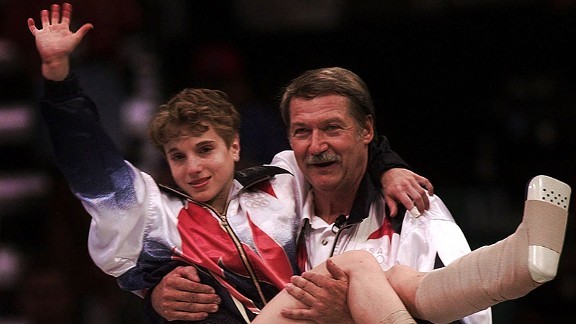“God help me out somehow,” whispered Kerri Strug, a two-time Olympian and gold medalist, as she was one perfect vault away from winning the 1996 Olympics.1 Kerri was the youngest in the 1992 Olympics in Barcelona at the age of fourteen. After her travels and rigorous training, at the age of eighteen, Strug achieved her goal of qualifying for the 1996 U.S. Olympic Team for gymnastics. Going into her second Olympics in 1996, Strug could have never expected the spotlight and the loyal fans she gained from her motivational vault.2 Kerri Strug’s final vault was over in the blink of an eye, but her determination and drive still continues to inspire people all over the world. Strug was a gymnast who overcame many obstacles in her journey to win several Olympic medals. Her comeback from the 1992 Olympics was the build-up of her astonishing performances. Strug’s downfalls and fierce comebacks kept her on the road, which led to her successes and the up-lifting of her inspiration.
The successes of her sister in gymnastics inspired Kerri to be exactly like her by becoming a gymnast herself. Kerri’s sister, Lisa Strug, was coached by the famous Bela Karolyi; as a young athlete, Strug automatically knew what she wanted in order to gain the help she knew she needed to be successful. At the age of eight, Kerri competed in her first meet, increasing her interest and passion for the sport. As Kerri Strug grew older, she insisted she should be coached by Bela Karolyi as well. Although she begged for his intensive coaching, he made sure it did not happen unless Kerri moved away from her home in Tucson, Arizona and moved to his Houston-based gymnasium. Strug and her parents agreed to let her move away to Houston and allow Bela to take full responsibility for her. And at the age of thirteen, Kerri began preparing for the 1992 Olympics.3
Even though Kerri joined gymnastics because of the enormous passion she had for the sport, she took on a good deal of training, which was thought to be the reason for her successes in all competitions. Kerri trained six to seven days a week, and each training day consisted of a total of eight hours.4 As part of her training, Coach Bela and his wife Martha strictly enforced healthy nutrition diets. They kept their eyes on the gymnasts’ food intake from the time they woke up to the time they went to bed. The girls’ nutrition was the main thing that was going to keep them in the running for the 1992 US Olympic Team. Barcelona’s 1992 Olympics was a whole lot closer than it seemed to Kerri. The last Olympic trials had been held in Baltimore. In this competition, Kerri performed some of her best, putting herself up in the top picks. When it came down to the event she was known for, things didn’t go as planned. In her floor routine, she fell after an aggressive tumbling pass caused her to lose points. Although she thought that this would affect her chances of making the team, it did not do so at all. Strug ended up being the sixth pick for the Olympic team! Kerri felt accomplished knowing that she made the Team, but she made sure she did not settle for it. Going into the Olympics, Kerri’s goal was to qualify for the individual competition, which she did not when the time came. When the entire team received a bronze medal, she was not satisfied with how she performed. This only motivated her to continue training to increase her chances of once again getting into the 1996 Olympics and to qualify for the individual competition.

As soon as the 1992 Olympics came to an end, Kerri’s mind was already set on the next one. But little did she know that she was going to have trouble finding a coach that she could have the utmost trust in, and one she felt comfortable enough to be coached by. Coach Bela decided he was going to retire from coaching, and announced it to his gymnasts right after they completed their performances and bronze medal ceremony. Bela left his prodigies with no coach and no gym to return to.

With this information, Kerri wanted to stop allowing gymnastics control her life. But she felt like she couldn’t just forget about the sport. For the next three years, she jumped from gym to gym, but was never able to find one that felt like home, or even a coach that pushed her to her limits, as Bela had done.5 With all of this going on, Strug had trouble competing at her highest potential. At one of her non-medal competitions, Kerri badly tore her stomach muscle, resulting in keeping her out of gymnastics for a total of six months. She decided to return home and finish school. Once Kerri was cleared from her torn muscle, she went back to training, and competed in yet another non-medal competition in California. Here she was injured again with pulling her back muscles. With this injury, she was out for an additional six months. Due to her injury, Kerri decided to complete high school in a positive way, and she was then accepted into UCLA, but she turned their offer down.
Kerri was on a decline in the gymnastics world, starting with not qualifying for the individual competition in the 1992 Olympics, Coach Bela retiring, and her injuries during the time of her searching for a coach and gym. With the handful of troubles Kerri had encountered, her mind was full of doubt. She was unsure of herself, and she had lost all motivation. Kerri had no drive to go to college either, and she made the decision to take some time off from school. After awhile, in 1994, Strug heard a rumor about Bela returning from his retirement, causing her to begin her search for him. Kerri knew that this journey was going to be tough, getting back into gymnastics; but the only way it was going to be viable was if Bela Karyoli were her coach. Strug made sure he was her coach again, and went straight to him for his fierce attitude and training. Now this was just the start of Strug’s comeback. Kerri qualified for the 1996 Olympic Team, and her one goal other than receiving a team gold medal was to qualify for the Individual Competition, since she failed to do so at her last Olympics. Kerri knew that this was not going to be the easiest and it was significant that she was precise with every event she performed in.
The 1996 Gymnastics Olympics was an intense one. The Russians and the Americans were going head to head for gold, and the final vault of Kerri Strug’s was the tie breaker. She ran down the strip and hit the vault perfectly, but came clashing down to the mat, and began to cry. Kerri had injured her ankle, and knowing that her vault was on the line for gold, she got back up and attempted her last vault. “Go Kerri, you can do it! You can do it!” shouted Bela. Kerri motivated herself, saying “You will do this. You’re strong. You’re fast.” As she sprinted down the strip, somersaulting off the vault, she stuck the landing on one foot, leaving everyone in amazement with this stunning vault.6 It put Kerri in the qualifying list for the Individual Competition, and put the team in the standing for a gold medal!

Gymnasts do not get very much time to participate in the sport, considering their time frame is usually from the age of thirteen to eighteen. This makes it incredibly tough to create a successful career. Throughout the gymnastics years of Kerri Strug, she had accomplished a lot more than just winning Olympic gold and bronze medals. Strug always performed at her best potential knowing that there would be a time when she could no longer compete in the gymnastics world she found so heavenly. She went through doubts in carrying on her passion for gymnastics, but with the announcement of the returning of Coach Bela Karyoli, Kerri wanted more for her career as a gymnast. Kerri Strug faced many struggles between 1992 and the 1996 Olympics, but her extravagant vault and the clenching of her spot in the Individual Competition in the 1996 Olympics would have not existed if it were not for her and Coach Bela’s inspiration comeback.
- Mark Starr, “Leap of Faith,” Newsweek 128, no.6 (August 1996): 40. ↵
- Faye Bayers, “A Gutsy Vault Defines Spirit of Olympics,” Christian Science Monitor 88, no. 168 (July 1996): 1. ↵
- Faye Bowers, “A Gutsy Vault Defines Spirit of Olympics,” The Christian Science Monitor 88, no. 168 ( July 1996): 1. ↵
- Richard Zoglin and Susanna Schrobsdorff, “Kerri’s Leap of Faith,” TIME 148, no.7 (August 1996): 42. ↵
- Faye Bayers, “A Gutsy Vault Defines Spirit of Olympics,” Christian Science Monitor 88 (1996): 1. ↵
- Greg Bishop, “The Magnificent Seven,” Sports Illustrated 125, no. 1 (July 2016): 66-73. ↵



63 comments
Daniel Linstead
Kerri Strug, an inspiration. This young girl at the time just had a dream, a focus on becoming the best. Strut showed that in her dedication for the sport training 8 hours a day, and even when she came to a halt in her career she still pushed through. That is a sign of a true champion. She is an inspiration to all aspiring athletes of how hard you need to work to become the best.
Megan Copeland
Growing up playing sports I was always told you need to be tough. I remember hearing about this story of the olympic gymnast, Kerri Strug, and how she injured her ankle badly, but got back up and did what she needed to do for her team to win a gold medal. This article was really informative in that it explained how she took time off from gymnastics due to injuries and because her coach left. She showed dedication to the sport by tracking down her retired coach and by making a push for the 1996 olympics.
Brianna Ford
I have always heard about the olympian named Kerri Strug, but never knew her whole story. First and foremost, the fact that she was only 14 years old when she competed in the 1992 olympics, has me in awe. (That is unheard of.) However, it’s no surprise that she is competing at such a high level with the amount of training she would do a day. I do not know anyone who trains for more than 8 hours a day. That just shows how much dedication she had for her sport. I also admire how she was never satisfied with her performances, she was hungry for more each and every time. Although she hit a point in her career where everything just came to a halt, she kept moving forward. This article made me realized the amount of work these gymnasts do and their passion they have for the sport is unbelievable. They have gained my respect.
Daniela Duran
Reading this article was truly an enriching and inspirational experience! It is always interesting to witness how people strive to find the bravery they require to follow their dreams. As I read these words, I couldn’t avoid thinking how many times I would have given up, if that had been me. I did gymnastics for around 6 years, and knowing how demanding it can be, this story became even more admirable to me! After reflecting on this inspirational narrative, I can definitely say that resilience should be a part of all us, just as it was for Strung. Sometimes we only need to find someone that can help us, motivate us, and guide us like her coach did.Just as she demonstrated with her series of injuries and hardships, perusing our passions and dreams will almost never be easy, but as long as we truly feel motivated to do it, we definitely can. I loved the way in which the story was narrated! It made me feel intrigued and thrilled all the way long! Excellent article!
Marisa Shute
If this has already been addressed already I apologize but the photos of Kerri in this article are from the 1992 Barcelona Olympics, not Atlanta. Kerri was the youngest on the US team in Barcelona and was one of the last 14 year olds to be able to compete in the Olympics before the rules were changed.
Didier Cadena
The article did a great job of detailing some of the difficulties that athletes face as they train to be the best. I had no idea who Strung was before reading the article, but I am glad that I now do. She seems like a great inspiration for others who are interested in gymnastics. The article was really informative and was enjoyable to read.
Robert Rodriguez
Wow! Such a great article, lots of good details! I had never heard of this story before until now.. her great dedication to her passion and to getting a gold medal despite her injury were the reasons for her great success and a gymnast. Her success story is historic and will always be remembered.
Vanessa Tombo
This article demonstrated the difficulties that athletes go through as they continue to compete with metal and physical breakdowns. This article showed the importance of passion and willpower. It allowed readers to make reflections of their own lives. It inspires them to question themselves if they too were living their passions or if they were living in some else’s life.
Alexandra Cantu
I was watching a documentary about the Olympics and Kerri Strug story captivated my attention. Her story is truly inspirational. This article provided many information such as her influence and goals her tragic injury and her fearless act at the 1996 Olympics. Kerri Strug knew her teammates were counting on her and she knew she was capable of greatness, With the encouragement of her coach this story might have had a different ending. Thank goodness she persevered and the outcome was unbelievable.
Constancia Tijerina
I have read and heard about the story of the Olympian Kerri Strug and I will forever admire the dedication and devotion of her that she would push through an injury and miraculously win a gold medal. Reading this article truly portrays the excitements and anxiety of what is going to happen next. Overall I believe this article to be so well put together and to also be inspirational for anyone to read, great job!